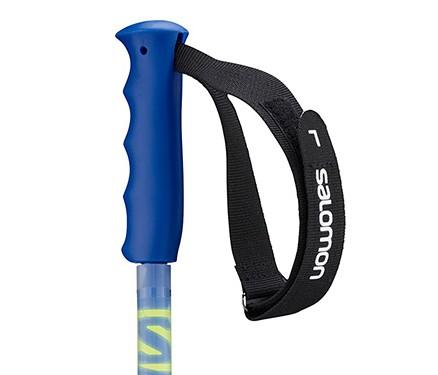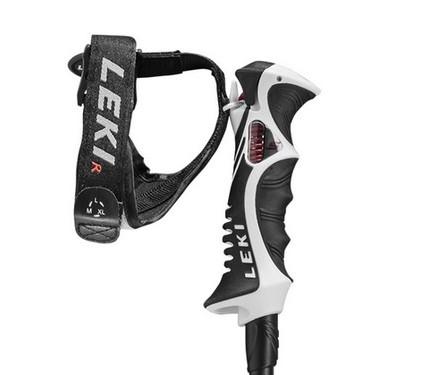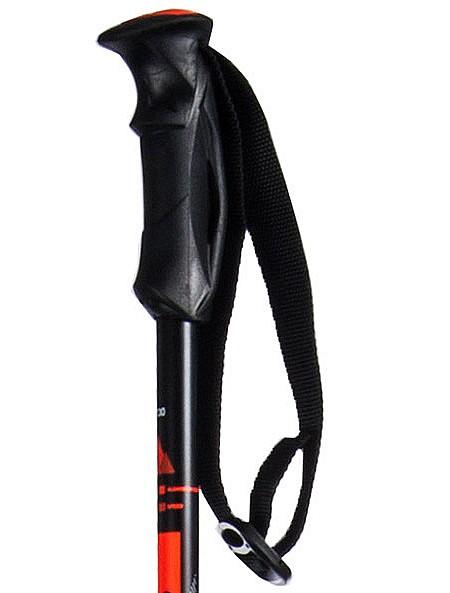Ski poles are essential accessories for skiing, helping you control your skis correctly by promoting proper upper body posture in relation to the slope. They also allow you to perform the classic pole plant, improving your balance and coordination.
For beginner skiers (1-star level or lower), ski poles are not essential. There are other basic skills to focus on before working on upper body position. Don’t hesitate to ask your instructor, who will be able to advise you.


How to choose the right size for alpine ski poles?
If you already own ski poles, here’s how to check if they are the correct height for you: Turn the pole upside down and place your hand underneath the basket. Your arm should form a 90° angle at the elbow. If your arm opens wider, the pole is too short, and if your arm lifts higher, the pole is too long.
Ski pole length guide based on skier height:
If you don't have ski poles, use the table below before buying:
| Skier height in cm | Pole length in cm |
|---|---|
| 200 | 140 |
| 190-200 | 135 |
| 185-190 | 130 |
| 175-185 | 125 |
| 170-175 | 120 |
| 160-170 | 115 |
| 155-160 | 110 |
| 145-155 | 105 |
| 135-145 | 100 |
| 125-135 | 95 |
| 115-125 | 90 |
| 105-115 | 85 |
| 105 | 80 |
What size ski pole for a child?
The size of ski poles for children is crucial for their comfort and progression. The method for choosing is similar to that for adults. Refer to our size chart! For younger children, it might be worth considering adjustable telescopic poles, which can adapt to their growth and last several seasons. Don't hesitate to explore our dedicated page to children's ski poles.
Anatomy of a ski pole:
A ski pole is made up of several parts: the grip, the strap, the shaft (tube or section), and the basket. Each part should be chosen with the utmost care.

Should you choose a one-piece pole or a telescopic pole for ski touring?
Most ski poles are made of a single shaft, also called a tube. For durability and weight reasons, one-piece poles suit the majority of skiers, for recreational and competitive use.

However, there are multi-piece poles (telescopic poles) that allow you to adjust the pole's length. They are used as ski touring poles because they enable you to adapt the length to the gradient.

What is the best material for a ski pole?
The different sections of a pole can be made from various materials, each offering specific mechanical properties. The most common are aluminium alloy poles, using zicral or dural for increased flexibility. They are lightweight without being expensive. Several types of aluminium exist: 7000 aluminium is known for its strength and good balance, while 5083 is very lightweight but not as strong.
There are also carbon fibre poles or fibreglass (composite) poles. They can be more expensive, but they are even lighter and stronger, especially carbon poles. Another benefit is the comfort, as the fibres have the advantage of absorbing vibrations.
Which basket to choose for your ski pole?
The basket is the lower end of the pole, just above the tip. Its purpose is to prevent your pole from sinking into the snow when applying pressure. Baskets vary depending on your skiing style, whether on groomed slopes or in powder. There are several types of baskets:
Piste baskets:
These are narrow and offer less wind resistance while being more durable. They are perfect for piste skiing on hard-packed or groomed snow.
Powder baskets:
Wider, they are essential in the backcountry to prevent your pole from disappearing into deep snow. However, they are more fragile and create more air resistance.
Be aware that each brand offers its own baskets, and they are rarely compatible with other pole brands.

Which strap to choose for your alpine ski pole?
The strap is usually a loop that fits around the skier's wrist to prevent losing the poles in case of a fall or if the grip is relaxed. It also provides extra support when pushing and pole planting. There are three main types of straps.
Classic single strap:
This is the most common type, a simple strap connected to the handle that forms a loop around your wrist. Although the design may vary between models and brands, they all function the same way. Different ergonomics can offer more comfort and a refined finish to your pole.
Breakaway strap:
A strap with a quick-release mechanism. More premium, safety straps provide many advantages in terms of support and comfort. The ability to detach in the event of a hard impact helps prevent wrist or thumb sprains.
Sword grip or strapless:
Without a strap but with plastic flaps. More exotic than the loop strap, strapless ski poles offer excellent grip and unparalleled ease of use. However, this grip type requires you to differentiate between your left and right poles. Strapless poles are rare as it non-adjustable.


What is the best grip for a ski pole?
The ski pole grip provides comfort. But remember, you’ll be wearing gloves, so the different foam textures will be absorbed by them. That said, soft foam grips are lighter and more comfortable. Finally, smaller hands will generally feel more comfortable with ‘index plus three fingers’ grips than with four-finger grips.


Different needs for different disciplines
Alpine ski poles
For alpine skiing, one-piece poles are the most commonly used, usually made of aluminium, with small or medium baskets. This makes them lighter with less wind resistance, allowing for better speed control.
Freeride ski poles
In freeride skiing, the poles may be slightly longer as they can sink deeper into the powder. The baskets are wide to prevent the poles from penetrating too far into the snow and to provide solid support.
Freestyle ski poles
Freestyle poles vary mainly depending on your level and preferences. Beginners can use standard poles to maintain good balance, while more experienced skiers opt for shorter, lighter poles to avoid hindrance during tricks. It's also recommended to use poles without straps to reduce the risk of injury during a fall.
Cross-country and skating poles
Skating requires longer poles than alpine skiing, typically around 20 cm shorter than the skier's height, and 30 cm shorter for classic cross-country skiing. Longer poles are needed for strong support, enabling more powerful strides.
Ski touring poles
Ski touring involves carrying heavy and bulky equipment. It's advisable to use lightweight, foldable poles that can be easily stowed away, or telescopic poles to adjust the length to the varying gradient.
Roller skiing poles
These specialised poles do not require baskets and feature a tungsten tip that is durable and resistant to impact on concrete.
